#Anthropology of religion
Text
Going to start referring to cumbrains as "Kinseyans," and insisting they accept different "interpretations" of the DSM-V so that it doesn't *really* deny the existence of pornography addiction.
Also going to note how the members of the governing bodies that determined the content of the DSM 5 were surrounded from youth by Hooters, Victoria's Secret, and adult video stores on all sides, so their denial of porn addiction needs to be placed in its proper cultural and historical context.
#Alfred Kinsey#dsm 5#DSM-5#Kinseyanity#Kinseyans#Addiction#addiction recovery#hermeneutics#Anthropology of religion#Secular creed#Secular cults#Fundamentalism#Not so funny once your reversed texts are put under the lens of historical criticism is it?#dsm#diagnostic statistical manual 5
5 notes
·
View notes
Link
“Será mesmo que os evangélicos são tolerantes?”: resenha do livro “Povo de Deus” de Juliano Spyer (por Silas Fiorotti, A Pátria, Funchal, 13/5/2022).
#evangélicos#evangelicals#livros#leituras#books#book review#review#anthropology#anthropology of religion#brazil#juliano spyer#geração editorial
3 notes
·
View notes
Text
Literally every conversation with a colleague/peer in the academic field I'm in (anthropology, with a focus on human prehistory and human evolution) upon them learning I'm an observant religious Jew goes like this:
Person: "Sorry if this is a personal question, but how do you.... y'know......deal with it?"
Me: "Deal with what?"
Person: "Y'know...... y'know......your religion......"
Me: "Meaning?"
Person: "Well, um, how old do you believe the earth is?"
Me: "I follow the geological consensus, which is approximately 4.5 Billion years"
Person: "But......but.....your Bible says that it's 6,000 years old....."
Me: "Technically 5,783 years, so you're wrong there, haha"
Person: "Okay but how do you....how do you reconcile that with science?"
Me: "I don't need to reconcile it. They're not in opposition."
Person: "??"
Me: "The plain text in the Tanakh states that it has been 5,783 years since the creation of Adam, and consequently the world. Judaism has never been about taking the text in the Tanakh plainly, there's always deeper meanings. Who's to say that the 5,783 years aren't just the years since a couple named Adam and Eve met and copulated, triggering the begining of the lineage of Abraham, Moses, and the entire Jewish lineage, and that the six days of creation aren't six phases which are actually pretty in-line with our understanding of evolution?"
Person: "But.....some people believe that it's literally been 5,783 years since the earth was literally created!"
Me: "Okay..... that's what they believe. I don't see how it should bother me, especially considering we're in the field of anthropology where we try to study other patterns of belief, not cast judgement upon them."
Person: "But other Jews believe that!!!"
Me: "Again.....why should that affect my religious and academic senses of self? Judaism has never been a monolith of belief, anyway."
Person: "But-"
#for real it's so tiring#i literally could not give two shits what other people believe#and considering anthropology's history with mocking indigenous creation stories quite frankly you people should be doing better#anthropology#religion#judaism#personal
7K notes
·
View notes
Text
Emerald Spectacles from India, c. 1620-1660 CE: the lenses of these spectacles were cut from a single 300-carat emerald, and it was believed that they possessed mystical properties

These eyeglasses are also known by the name "Astaneh-e ferdaws," meaning "Gate of Paradise," based on the symbolic associations between the color green and the concept of spiritual salvation/Paradise. That symbolism (which is rooted in Islamic tradition) was especially popular in Mughal-era India, where the spectacles were made.

The lenses were crafted from two thin slices of the same emerald. Together, the lenses have a combined weight of about 27 carats, but given the precision, size, and shape of each lens, experts believe that the original emerald likely weighed in excess of 300 carats (more than sixty grams) before it was cleaved down in order to produce the lenses. The emerald was sourced from a mine in Muzo, Colombia, and it was then transported across the Atlantic by Spanish or Portuguese merchants.
Each lens is encircled by a series of rose-cut diamonds, which run along an ornate frame made of gold and silver. The diamond-studded frame was added in the 1890s, when the original prince-nez design was fitted with more modern frames.
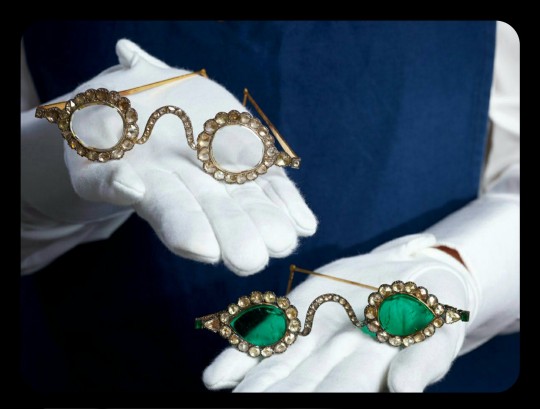
The emerald eyeglasses have long been paired with a second set of spectacles, and they were almost certainly commissioned by the same patron. This second pair is known as "Halqeh-e nur," or the "Halo of Light."
The Halo of Light features lenses that were made from slices of diamond. The diamond lenses were cleaved from a single stone, just like the emerald lenses, with the diamond itself being sourced from a mine in Southern India. It's estimated that the original, uncut diamond would have weighed about 200-300 carats, which would make it one of the largest uncut diamonds ever found.

The lenses are so clear and so smoothly cut that it sometimes looks like they're not even there.
Both sets of spectacles date back to the mid-1600s, and it's generally believed that they were commissioned by a Mughal emperor or prince. The identity of that person is still a bit of a mystery, but it has been widely speculated that the patron was Shah Jahan -- the Mughal ruler who famously commissioned the Taj Mahal after the death of his wife, Mumtaz Mahal. Shah Jahan did rule as the Mughal emperor from about 1628 to 1658.
The emerald and diamond lenses may have been chosen for symbolic, sentimental, and/or cultural reasons, or they may have been chosen simply because they're pretty and extravagant; the original meaning and purpose behind the design is still unclear. Experts do believe that the eyeglasses were designed to be worn by someone, though.
At times, it was believed that the spectacles had spiritual properties, like the ability to promote healing, to ward off evil, to impart wisdom, and to bring the wearer closer to enlightenment. Those beliefs are largely based on the spiritual significance that emeralds and diamonds can have within certain Indic and Islamic traditions -- emeralds may be viewed as an emblem of Paradise, salvation, healing, cleansing, and eternal life, while diamonds are similarly associated with enlightenment, wisdom, celestial light, and mysticism.
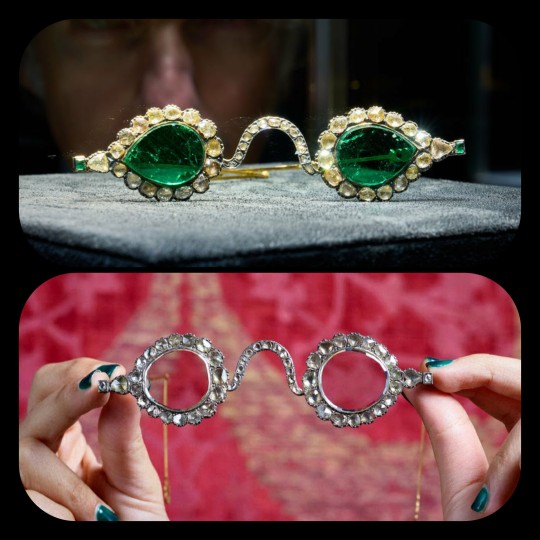
The Gate of Paradise and the Halo of Light were both kept in the collections of a wealthy Indian family until 1980, when they were sold to private collectors, and they were then put up for auction once again in 2021. They were most recently valued at about $2 million to $3.4 million per pair.
Sources & More Info:
Sotheby's: Mughal Spectacles
Architectural Digest of India: At Sotheby's auction, Mughal-era eyeglasses made of diamond and emerald create a stir
Only Natural Diamonds: Auspicious Sight & the Halqeh-e Nur Spectacles
The Royal Society Publishing: Cleaving the Halqeh-Ye Nur Diamonds
Gemological Institution of America: Two Antique Mughal Spectacles with Gemstone Lenses
Manuscript: From Satan's Crown to the Holy Grail: emeralds in myth, magic, and history
CNN: The $3.5 million Spectacles Said to Ward off Evil
BBC: Rare Mughal Era Spectacles to be Auctioned by Sotheby's
#history#archaeology#artifact#mughal#india#17th century#art#emerald#diamond#glasses#indian lore#islam#religion#mysticism#indian history#anthropology#spirituality#fashion
4K notes
·
View notes
Text
hi guyss :) im studying supernatural belief, religious belief, locus of control, and their relationship to evolutionary sex differences for my master's thesis!! i'd grately appreciate if yall can complete and share this survey:
#dark academia#chaotic academia#study motivation#study blog#religion#evolution#supernatural#destiel#human#human history#history#religious trauma#evolutionary biology#evolutionary psychology#evolutionary anthropology#high evolutionary
304 notes
·
View notes
Text
"the only explanation for all the art inside of caves is that it had spiritual, ritual, or cultic purposes"
the only explanation for all the art inside of modern people's houses is that it also has spiritual, ritual, or cultic purposes, then :|
like, c'mon now. i definitely don't believe that stone-age humans had no sense of "this is cool/pretty" nor sense of "this tells a story" nor anything else of the sort. the insistence that everything without an explanation in history is always for ~ritual purposes~ is so annoying. literally what evidence says that the shelters people used couldn't sometimes have just been fucking decorated?
#stfu blue#history#archaeology#anthropology#like? the stone age is not that long ago??#oh they can have ~primitive pseudo-religion~ but they can't just have joy. i see how it is
280 notes
·
View notes
Text
To understand mythologies, myths, folklores, folk tales, you kind of have to try to look at them through the eyes of those who lived and breathed during the eras when they were written, in the places where they were told and retold and passed down the generations.
You kind of have to learn how people lived and worked back then and where they were, how societies were structured and maintained, how cultures were made and kept, how things were in those time periods and how they impacted and influenced folks' ways of living and thinking.
If you only ever see them through a 21st century first world lens, I guarantee you, it just ain't gonna work.
#mother witch ramblings#witchblr#paganblr#mythologies#myths#folklores#folk tales#history#anthropology#folkloric witch#witches of color#religions
358 notes
·
View notes
Text
A whole volume could well be written on the myths of modern man, on the mythologies camouflaged in the plays that he enjoys, in the books that he reads. The cinema, that "dream factory," takes over and employs countless mythical motifs—the fight between hero and monster, initiatory combats and ordeals, paradigmatic figures and images (the maiden, the hero, the paradisal landscape, hell, and so on). Even reading includes a mythological function, not only because it replaces the recitation of myths in archaic societies and the oral literature that still lives in the rural communities of Europe, but particularly because, through reading, the modern man succeeds in obtaining an "escape from time" comparable to the "emergence from time" effected by myths. Whether modern man "kills" time with a detective story or enters such a foreign temporal universe as is represented by any novel, reading projects him out of his personal duration and incorporates him into other rhythms, makes him live in another "history."
Mircea Eliade, The Sacred and The Profane: The Nature of Religion
#quote#Mircea Eliade#Eliade#reading#cinema#film#art#books#religion#anthropology#culture#The Sacred and The Profane#sacred#profane#mythology#myth#time
63 notes
·
View notes
Text

The POPE??? Since when?? Since where????
#this throws all of my miraland religious studies into CHAOS#love nikki#ig this is the pope of the 'oriental religion' whatever that is#not pigeon catholicism#love nikki religious anthropology
85 notes
·
View notes
Text

By: Colin Wright
Published: Oct 2, 2023
On September 25, the American Anthropological Association (AAA) and the Canadian Anthropology Society (CASCA) announced that they were cancelling a panel discussion titled “Let’s Talk About Sex, Baby: Why Biological Sex Remains a Necessary Analytic Category in Anthropology,” originally scheduled as part of their annual conference in Toronto from November 15–19. The cancellation and subsequent response by the two organizations shows the extent to which gender ideology has captured academic anthropology.
The panel would have featured six female scientists, specializing in biology and anthropology, to address their profession’s growing denial of biological sex as a valid and relevant category. While terminological confusion surrounding the distinction between sex and gender roles has been a persistent issue within anthropology for decades, the total refusal of some to recognize sex as a real biological variable is a more recent phenomenon. The panel organizers, eager to facilitate an open discussion among anthropologists and entertain diverse perspectives on a contentious issue, considered the AAA/CASCA conference an optimal venue to host such a conversation.
The organizations accepted the “Let’s Talk About Sex” panel without incident on July 13, and planned to feature it alongside other panels including those on politically oriented subjects, such as “Trans Latinx Methodologies,” “Exploring Activist Anthropology,” and “Reimagining Anthropology as Restorative Justice.” Elizabeth Weiss, a professor of anthropology at San José State University, was one of the slated panelists. She had intended to discuss the significance in bio-archaeology and forensic anthropology of using skeletal remains to establish a decedent’s sex. While a 2018 article in Discover titled “Skeletal Studies Show Sex, Like Gender, Exists Along a Spectrum” reached different conclusions, Weiss planned to discuss how scientific breakthroughs have made determining the sex of skeletal remains a more exact science. Her presentation was to be moderate; she titled it “No Bones About It: Skeletons Are Binary; People May Not Be,” and conceded in her abstract the growing need in forensics to “to ensure that skeletal finds are identified by both biological sex and their gender identity” due to “the current rise in transitioning individuals and their overrepresentation as crime victims.”
Despite having already approved the panel, the presidents of the AAA (Ramona Pérez) and CASCA (Monica Heller) unexpectedly issued a joint letter on September 25 notifying the “Let’s Talk About Sex” presenters that their panel was cancelled. They claimed that the panel’s subject matter conflicted with their organizations’ values, jeopardized “the safety and dignity of our members,” and eroded the program’s “scientific integrity.” They further asserted the panel’s ideas (i.e., that sex is a real and important biological variable) would “cause harm to members represented by the Trans and LGBTQI of the anthropological community as well as the community at large.” To ensure that similar discussions would not be approved in the future, the AAA/CASCA vowed to “undertake a major review of the processes associated with vetting sessions at our annual meetings.”
The following day, the panelists issued a response letter, expressing their disappointment that the AAA and CASCA presidents had “chosen to forbid scholarly dialogue” on the topic. They rejected the “false accusation” that supporting the “continued use of biological sex categories (e.g., male and female; man and woman) is to imperil the safety of the LGBTQI community.” The panelists called “particularly egregious” the AAA/CASCA’s assertion that the panel would compromise the program’s “scientific integrity.” They noted that, ironically, the AAA/CASCA’s “decision to anathematize our panel looks very much like an anti-science response to a politicized lobbying campaign.”
I spoke with Weiss, who expressed her frustration over the canceled panel and the two presidents’ stifling of honest discussion about sex. She was concerned about the continual shifting of goalposts on the issue:
We used to say there’s sex, and gender. Sex is biological, and gender is not. Then it’s no, you can no longer talk about sex. Sex and gender are one, and separating the two makes you a transphobe, when of course it doesn’t. In anthropology and many topics, the goalposts are continuously moved. And, because of that, we need to stand up and say, “I’m not moving from my place unless there’s good scientific evidence that my place is wrong.” And I don’t think there is good scientific evidence that there are more than two sexes.
Weiss was not the only person to object. When I broke news of the cancellation on X, it immediately went viral. At the time of writing, my post has more than 2.4 million views, and the episode has ignited public outcry from individuals and academics across the political spectrum. Science writer Michael Shermer called the AAA and CASCA’s presidents’ letter “shameful” and an “utterly absurd blank slate denial of human nature.” Timur Kuran, a professor of economics and political science at Duke University, described it as “absolutely appalling.” Jeffrey Flier, the Harvard University distinguished service professor and former dean of the Harvard Medical School, viewed it as “a chilling declaration of war on scholarly controversy.” Even Elon Musk expressed his disbelief with a single word: “Wow.”
Despite the backlash, the AAA and CASCA have held firm. On September 28, the AAA posted a statement on its website titled “No Place For Transphobia in Anthropology: Session Pulled from Annual Meeting Program.” The statement reiterated the stance outlined in the initial letter, declaring the “Let’s Talk About Sex” panel an affront to its values and claiming that it endangered AAA members’ safety and lacked scientific rigor.
The AAA’s statement claimed that the now-canceled panel was at odds with their first ethical principle of professional responsibility: “Do no harm.” It likened the scuttled panel’s “gender critical scholarship” to the “race science of the late 19th and early 20th centuries,” the main goal of which was to “advance a ‘scientific’ reason to question the humanity of already marginalized groups of people.” In this instance, the AAA argued, “those who exist outside a strict and narrow sex/gender binary” are being targeted.
Weiss remains unconvinced by this moral posturing. “If the panel was so egregious,” she asked, “why had it been accepted in the first place?”
The AAA also claimed that Weiss’s panel lacked “scientific integrity,” and that she and her fellow panelists “relied on assumptions that ran contrary to the settled science in our discipline.” The panelists, the AAA argued, had committed “one of the cardinal sins of scholarship” by “assum[ing] the truth of the proposition that . . . sex and gender are simplistically binary, and that this is a fact with meaningful implications for the discipline.” In fact, the AAA claimed, the panelists’ views “contradict scientific evidence” about sex and gender, since “[a]round the world and throughout history, there have always been people whose gender roles do not align neatly with their reproductive anatomy.”
There is much to respond to in this portion of AAA’s statement. First, it’s ironic for the organization to accuse scientists of committing the “cardinal sin” of “assuming the truth” of something, and then to justify cancelling those scientists’ panel on the grounds that the panelists refuse to accept purportedly “settled science.” Second, the panel was organized to discuss biological sex (i.e., the biology of males and females), not “gender roles”; pivoting from discussions of basic biology to murkier debates about sex-related social roles and expectations is a common tactic of gender ideologues. Third, the AAA’s argument that a person’s “gender role” might not “align neatly” with his or her reproductive anatomy implies the existence of normative behaviors for members of each sex. Indeed, this is a central tenet of gender ideology that many people dispute and warrants the kind of discussion the panel intended to provide.
The AAA’s statement made another faulty allegation, this time against Weiss for using “sex identification” instead of “sex estimation” when assessing the sex of skeletal remains. The AAA claimed that Weiss’s choice of terminology was problematic and unscholarly because it assumes a “determinative” process that “is easily influenced by cognitive bias on the part of the researcher.”
Weiss, however, rejects the AAA’s notion that the term “sex determination” is outdated or improper. She emphasized that “sex determination” is frequently used in the literature, as demonstrated in numerous contemporary anthropology papers, along with “sex estimation.” Weiss said, “I tend not to use the term ‘sex estimation’ because to estimate is usually associated with a numeric value; thus, I do use the term ‘age estimation.’ But just as ‘age estimation’ does not mean that there is no actual age of an individual and that biological age changes don’t exist, ‘sex estimation’ does not mean that there isn’t a biological sex binary.” She also contested the AAA’s claim that anthropologists’ use of “sex estimation” is meant to accommodate people who identify as transgender or non-binary. Rather, she said, “sex estimation” is used when “anthropologists are not 100 [percent] sure of their accuracy for a variety of reasons, including that the remains may be fragmented.” But as these methods improve—which was a focus of her talk—such “estimations” become increasingly determinative.
After making that unfounded allegation against Weiss, the AAA further embarrasses itself by claiming that “There is no single biological standard by which all humans can be reliably sorted into a binary male/female sex classification,” and that sex and gender are “historically and geographically contextual, deeply entangled, and dynamically mutable categories.”
Each of these assertions is empirically false. An individual’s sex can be determined by observing their primary sex organs, or gonads, as these organs determine the type of gamete an individual can or would have the function to produce. The existence of a very rare subset of individuals with developmental conditions that make their sex difficult to assess does not substantiate the existence of a third sex. Sex is binary because are only two sexes, not because every human in existence is neatly classifiable. Additionally, while some organisms are capable of changing sex, humans are not among them. Therefore, the assertion that human sex is “dynamically mutable” is false.
Weiss appropriately highlights the “false equivalency” inherent in the claim that the existence of people with intersex conditions disproves the binary nature of sex. “People who are born intersex or with disorders of sex development are not nonbinary or transgender, they are individuals with medical pathologies,” she said. “We would not argue that because some people are born with polydactyly (extra fingers or toes), often seen in inbred populations, that you can’t say that humans have ten fingers and ten toes. It's an absurd conclusion.”
On September 29, the AAA posted a Letter of Support on its website, penned by anthropologists Agustin Fuentes, Kathryn Clancy, and Robin Nelson, endorsing the decision to cancel the “Let’s Talk About Sex” session. Again, the primary motivation cited was the panel’s opposition to the supposed “settled science” concerning sex. The authors disputed the panelists’ claim that the term “sex” was being supplanted by “gender” in anthropology, claiming instead that there is “massive work on these terms, and their entanglements and nuances.” They also reiterated the AAA’s false accusation that the term “sex determination” was problematic and outdated. Nonetheless, the canceled panel could have served as a prime venue to discuss these issues.
In response to these calls for censorship, the Foundation for Individual Rights and Expression (FIRE) issued an open letter to the AAA and CASCA. FIRE characterized the groups’ decision to cancel the panel as a “retreat” from their scientific mission, which “requires unwavering dedication to free inquiry and open dialogue.” It argued that this mission “cannot coexist with inherently subjective standards of ‘harm,’ ‘safety,’ and ‘dignity,’ which are inevitably used to suppress ideas that cause discomfort or conflict with certain political or ideological commitments.” FIRE implored the AAA and CASCA to “reconsider this decision and to recommit to the principles of intellectual freedom and open discourse that are essential to the organizations’ academic missions.” FIRE’s open letter has garnered signatures from nearly 100 academics, including Harvard psychologist Steven Pinker and Princeton University’s Robert P. George. FIRE invites additional academic faculty to add their names.
The initial letter and subsequent statement by the AAA/CASCA present a particularly jarring illustration of the undermining of science in the name of “social justice.” The organizations have embarrassed themselves yet lack the self-awareness to realize it. The historian of science Alice Dreger called the AAA and CASCA presidents’ use of the term “cardinal sin” appropriate “because Pérez and Heller are working from dogma so heavy it is worthy of the Vatican.” Indeed, they have fallen prey to gender ideologues, driven into a moral panic by the purported dangers of defending the existence of biological sex to people whose sex distresses them. The AAA/CASCA have determined that it is necessary not only to lie to these people about their sex but also to deceive the rest of us about longstanding, foundational, and universal truths about sex.
Science can advance only within a system and culture that values open inquiry and robust debate. The AAA and CASCA are not just barring a panel of experts with diverse and valid perspectives on biological sex from expressing their well-considered conclusions; they are denying conference attendees the opportunity to hear diverse viewpoints and partake in constructive conversations on a controversial subject. Such actions obstruct the path of scientific progress.
“When you move away from the truth, no good can come from it,” Weiss says. The AAA and CASCA would be wise to ponder that reality.
==
I miss the days when anti-science meant creationists with "Intelligent Design," flat Earthers, and Jenny McCarthy-style MMR anti-vaxers.
It's weird that archaeologists are now denying evolution and pretending not to know how babies are made. Looks like creationists aren't the only evolution-denial game in town any more.
#Colin Wright#anti science#gender ideology#queer theory#anthropology#biology denial#sex is binary#censorship#disinvitation#cancel culture#genderwang#moral panic#biological sex#biology#human biology#ideological corruption#ideological capture#gametes#religion is a mental illness
130 notes
·
View notes
Text
Free Folk & Their Adaptive Strategy
Adaptive strategy was a term first coined in 1974 by anthropologist Yehudi Cohen to describe a society's means of economic production. Cohen also further postulated that certain means of economic production adopted by a society also led said society to adopt certain social features, by which I mean shared political organization, and similar ways of choosing leadership, if they had any.
Now, in most anthropological circles, it's generally agreed there are five adaptive strategies to be linked to five types of political organization. This is a general pattern across a majority of human societies, but not a written-in-stone rule; some societies do not land in these neat, categorized boxes. However, this is a fictional culture, so for the sake of mine and the dear reader's sanity, we are going to assume the Free Folk fall into these categories.
It is largely implied that the Free Folk's main adaptive strategy is foraging, employing “traditional” hunter-gatherer means of survival. Now we see some Free Folk use pastoralist means of survival, with mentions of sheepfolds and pigstys found in various Free Folk villages, as well as a mention of a reindeer herding, however, baseline the Free Folk are foragers. Usually, in forager societies, the main type of political organization are bands, relatively small groups of people all tied together by some form of kinship. This seems to be supported in the text itself, where Jon refers to Rattleshirts’ group as a “band” several times.
This type of society does not lend itself well to permanent homes, usually moving seasonally in accordance with where herds of wild animals have moved. The idea of private property is virtually nonexistent. However, there are reports of forager societies all coming together in one place, usually when there is a surplus of food. This occasion is usually treated like a holiday, with lots of celebrating, dancing, singing, and trading being done.
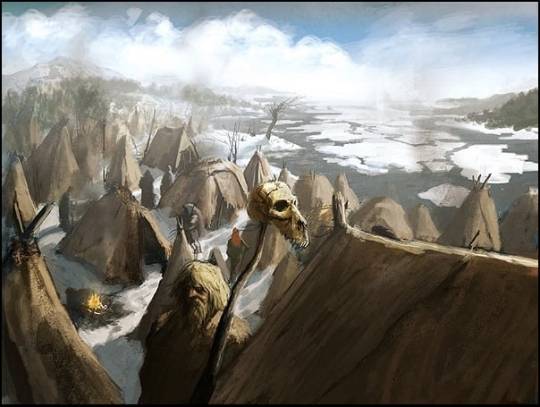
Leadership: Fascinatingly enough, forager leadership structure is usually based around who can give the most, rather than who is the strongest or the toughest. This is due to the tendency of forager societies to develop social mores involving hospitality and shared social responsibility.
Social Values: We already know the Free Folk hold proper hospitality to be absolutely sacred, with even Crastor, the worst of the worst, following it like gospel. (He is not the one to break hospitality during the Night’s Watch coup, after all.) The shared social responsibility part is simply an expansion of this core idea. If you can’t even take care of your own, why should your hospitality, your word be trusted? Societies like this one, also will ostracize any hoarders who take more than they need. We see this pattern with Crastor, with every other Free Folk we meet despising him. Granted, this is probably due to his practice of marrying his daughters, but he is also the only Free Folk to have a designated “keep”, where his family lives, with it’s own pigsty and sheepfold. Every other pigsty and/or sheepfold we see north of the Wall, appears to be shared. Some of that disgust could also be due to his hoarding tendencies.
Gender Roles: White there is the traditional idea of men doing the hunting and fishing and women doing the majority of the foraging, these roles are not set in stone by any means. Again, this is supported by the text, where both men and women are raiders and accepted leaders of their groups. This is even supported in the Free Folks’ concept of marriage, which doesn’t seem to be set in stone. They do have a concept of one man and one woman being tied together, but it doesn;t seem that the two are bound by marriage; there is no expectation of fidelity for either party, or at least there are no social consequences for sleeping with someone who isn’t your spouse. This kind of openness is usually found in societies that give their women a lot more freedom.
Religion: Due to their heavy reliance on the land, almost all foraging societies are animistic, worshiping the spirits found in and around nature, rather than a specific, titled entity. Again seen in the Free Folk, who worship the Old Gods, nameless spirits inhabiting the world around them.
Inheritance Customs: As there is no concept of private property, there is no concept of someone inheriting that private property. Further support the Free Folks’ lax gender roles. When there is nothing to inherit, why should there be a huge fuss over whose child is whose child? Why should a husband need to control who his wife sleeps with, when he has nothing to pass down?
Descent Customs: Forager societies are often bilineal, children are considered to be descended from both parents and thus kin to both parents’ extended families. This is a way to ensure that there will always be someone to rely on in hard times. I see no reason why the Free Folk would not adopt a similar strategy.
This is just some of the things, affected by the Free Folks’ larger adaptive strategy, there are probably a hundred more different ways this idea could be expressed. But anyway, let me know what you think!
#asoiaf#free folk#worldbuilding#anthropology#customs#the wall#jon snow#religion#culture#archaeology#ill be writing a similar post on the dothraki and their adaptive strategy#because i am incensed at how little canon gave us#otherwise friendly reminder: no culture is a monolith#there are exceptions to every rule
53 notes
·
View notes
Link
“Jaime Gonçalves: A Bishop’s Perspectives that Challenge Official Narratives in Mozambique” by Silas Fiorotti (In: Journal of Religion in Africa, v. 52, 2022: 395-420).
#jaime pedro gonçalves#mozambique#african studies#estudos africanos#journal of religion in africa#brill#scientific journals#paper#moçambique#history of africa#politics#frelimo#renamo#religion and politics#anthropology#anthropology of religion
1 note
·
View note
Note
Thoughts on creationist?
I'm going to assume you mean "Creationism".
Now, this might make some of my colleagues in the anthropology sphere upset......but I literally don't care about the existence of Creationists. If someone believes that the Earth is only 6000 years old, or that evolution isn't real, etc, it's really none of my business what they believe. Every culture is entitled to their origin stories, and as long as they're not hurting anyone with their beliefs, it's not my place to try and suppress them.
I believe that the Earth is far old than 6000 years old and that evolution is real. I believe that the universe started from the collision of hydrogen atoms, and that it took millions and billions of years for the Earth to become what it is today. But I also believe that the entity that started everything, that put this process into action and continues to allow the universe to exist- is G-d. For me, learning about science makes me believe in G-d more.
But...there are those that don't believe in a G-d, or don't believe the universe is as old as science says it is. And that's okay. I'm not going to tell Creationists that they're wrong anymore than I'm not going to go to other cultures and say that their creation stories are wrong. As an anthropologist, I respect all cultures and I exist to study and empower them, not to put them down or try to change them.
Now, just like I don't mock Creationist beliefs, I don't believe Creationists should mock mine. I believe we should be able to coexist without science alienating Creationists and without Creationists demonizing science. Ultimately, Truth is relative, and we should be able to respect other people's Truths and expect for our Truths to be respected in return.
I don't seek to make everyone in the world believe in the same things I do, and I hope to live in a world where that is the norm, not the exception.
Judaism's rule against proselytizing for me extends to proselytizing about Western science. I don't do it.
#jumblr#i guess#religion#belief#science#anthropology#evolution#creationism#religion and science can coexist#religious freedom
271 notes
·
View notes
Text
Medieval Hermitage atop Katskhi Pillar, in Georgia (South Caucasus), c. 800-900 CE: this church was built during the Middle Ages; it sits atop a limestone column that has been venerated as a "Pillar of Life" for thousands of years

Known as Katskhi Pillar (or Katskhis Sveti), this enormous block of limestone is located in western Georgia, about 10km from the town of Chiatura.
The church that stands atop Katskhi Pillar was originally constructed during the 9th-10th century CE. It was long used as a hermitage for Stylites, who are sometimes referred to as "Pillar Saints" -- Christian ascetics who lived, prayed, and fasted atop pillars, often in total isolation, in an effort to bring themselves closer to God. This tradition originated in Syria during the 5th century CE, when a hermit known as Simeon the Elder purportedly climbed up onto a pillar and then stayed there for nearly 40 years, giving rise (no pun intended) to the Stylites. Stylitism managed to survive for about 1,000 years after its inception, but it gradually began to die out during the late Middle Ages, and by the end of the 16th century, it had essentially gone extinct.
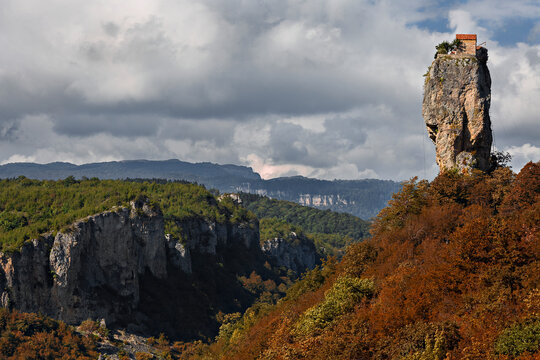
Researchers don't really know how the monks originally gained access to the top of Katskhi Pillar, or how they were able to transport their building materials up to the top of the column. There's evidence that the Stylites were still living at Katskhi Pillar up until the 15th century, but the site was then abandoned shortly thereafter. This was the same period in which Georgia came under Ottoman rule, though it's unclear whether or not that may have played a role in the abandonment of the site.
The hermitage continued to lay abandoned for nearly 500 years after that. No one had been able to gain access to the top of the pillar, and very little was even known about the ruins that lay scattered at the top, as knowledge about the site's origin/history was gradually lost. There are many local legends that emerged as a way to fill in those blanks.
The site was not visited again until July 29th, 1944, when a mountaineer finally ascended to the top of the column with a small team of researchers, and the group performed the first archaeological survey of the ruins. They found that the structure included three hermit cells, a chapel, a wine cellar, and a small crypt; within the crypt lay a single set of human remains, likely belonging to one of the monks who had inhabited the site during the Middle Ages.
A metal ladder (the "stairway to Heaven") was ultimately installed into the side of the pillar, making it much easier for both researchers and tourists to gain access to these ruins.

The hermitage at the top of Katskhi Pillar actually became active again in the early 1990's, when a small group of monks attempted to revive the Stylite tradition. A Georgian Orthodox monk named Maxime Qavtaradze then lived alone at the top of Katskhi Pillar for almost 20 years, beginning in 1995 and ending with his death in 2014. He is now buried at the base of the pillar.
While the hermitage is no longer accessible to the public, and it is currently uninhabited, it's still visited by local monks, who regularly climb up to the church in order to pray. There is also an active monastery complex at the base of the pillar, where a temple known as the Church of the Simeon Stylites is located.

The Church of the Simeon Stylites: this church is located within an active monastery complex that has been built at the base of the pillar; several frescoes and religious icons decorate the walls of the church, and a small shrine containing a 6th century cross is located in the center
There are many lingering questions about the history of Katskhi Pillar, particularly during the pre-Christian era. There is at least some evidence suggesting that it was once the site of votive offerings to pagan deities, as a series of pre-Christian idols have been found buried in the areas that surround the pillar; according to local tradition, the pillar itself was once venerated by the pagan societies that inhabited the area, but it's difficult to determine the extent to which these claims may simply be part of the mythos that surrounds Katskhi Pillar, particularly given its mysterious reputation.
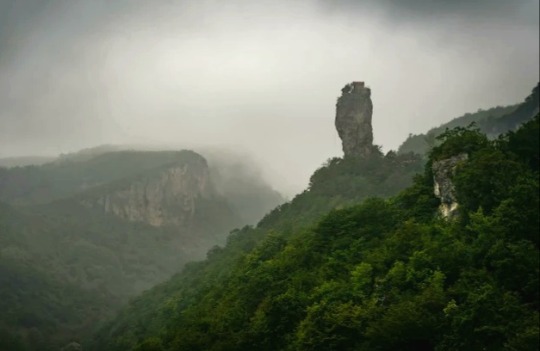
Sources & More Info:
BBC: Georgia's Daring, Death-Defying Pilgrimage
CNN: Katskhi Pillar, the Extraordinary Church where Daring Monks Climb Closer to God
Radio Free Europe: Georgian Monk Renews Tradition, Lives Atop Pillar
Architecture and Asceticism (Ch. 4): Stylitism as a Cultural Trend Between Syria and Georgia
Research Publication from the Georgian National Museum: Katskhi Pillar
Journal of Nomads: Katskhi Pillar, the Most Incredible Cliff Church in the World
Georgian Journal: Georgia's Katskhi Pillar Among World's 20 Wonderfully Serene and Secluded Places
#archaeology#history#anthropology#artifact#medieval architecture#medieval church#Stylites#asceticism#georgia#sakartvelo#katskhi pillar#religion#travel#monastery#paganism#caucasus#medieval europe#christianity#strange places
449 notes
·
View notes
Text


can you believe he's a history major
#[.art]#genshin impact#wanderer#'history major' is how I interpret that segment but I guess it's social sciences in general. Philosophy major scara /j#I think he would he the type to read Nietzsche and develop mental illness about it. He does also strike me as a Hegel guy#and as a Feuerbach enjoyer. Religion as reverse anthropology theory 'an objectification of human wishing about limitless existence' enjoyer#anyways. Of course my main would be a history student. Iocore mi hanno messo in genshin impact
101 notes
·
View notes
Text
That one user blocked me, but I already had part of a reply saved to drafts so might as well not waste it!
Now it is true that no religion is scientifically proven.
But I'm not talking about proving religions themselves. I'm talking about studying the psychology of religious practices. That is science.
To be completely clear: I'm a completely materialist atheist. I view the world in terms of matter and energy, and nothing more. I don't believe in gods. I don't believe in spirits. I don't believe in souls or reincarnation.
But spiritual experiences are still actual experiences that can be studied scientifically. They ARE studied scientifically. All the time. They've even been compared to both mental illnesses and primarily-secular practices like tulpamancy.
You can't prove that a Vineyard Evangelical is communing with God. But you can demonstrate that the practices used by the Vineyard Evangelicals can result in hallucinatory voices that are attributed to God.
You can demonstrate that practices of groups experiencing spiritual possession can induce multiple "distinct personality states."
Psychology, sociology and anthropology are just a few fields that will study religion and religious practices.
Research into the real psychological effects of religious practices isn't invalidated just because you're researching a religion. And dismissing these as valid fields of study is inherently anti-science.
#syscourse#psychology#anthropology#atheism#religion#spirituality#system stuff#sysblr#multiplicity#possession#sociology#pro endo#pro endogenic#systems#endogenic#science#tulpa#tulpamancy#pro tulpa#plural
107 notes
·
View notes